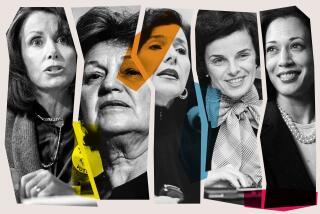A First-Rate Look at Ladies of the House : The Richard Nixon Library & Birthplace’s inaugural lecture series, on ‘Great Wives of Great Presidents’ will look at imprints and impacts.
- Share via
Hillary Clinton has Washington insiders buzzing, and this time it’s not about bleaching her brown bob, discarding her preppy headbands or the antics of the family cat.
They’re wondering: Will she be able to change the way Americans view the traditional role of the First Lady?
“Mostly likely, she will,” says Polly Willman, a conservator for the Smithsonian Institution. Because Hillary Clinton is a high-powered corporate lawyer and a recognized expert on family law, she will want something formal and official in her new capacity, Willman speculates. “She may end up with a title beyond First Lady, in addition to First Lady. Since she’s a lawyer, there could be a judicial appointment.”
Along with other authorities of First Ladyship, Willman will speak at the Richard Nixon Library & Birthplace’s inaugural lecture series, “The Lady of the House: Great Wives of Great Presidents.” The program begins today when Julie Nixon Eisenhower discusses the historical imprint left by Pat Nixon and Mamie Eisenhower.
Of the nation’s interest in Hillary Clinton’s new role, Willman (who will speak at the library in Yorba Linda on Jan. 21) says: “I think everyone is making a big noise because Barbara Bush has been so traditional. She didn’t speak separately about issues during her husband’s presidency. He had the position. She has been the classic traditional politician’s wife.”
Which is not to say Barbara Bush lacked power. “The First Lady has enormous power,” says manners expert Letitia Baldridge, White House chief of staff for Jacqueline Kennedy. “It may be a back-breaking, heart-wrenching job, but it is terribly important.
“She’s the one who sits next to heads of state at all of those dinners and lunches. The President doesn’t. He sits next to their spouses.
“And when it comes to the Congress, the First Lady has the opportunity of working with its members to put forth legislation she wants,” notes Baldridge, whose Nixon library engagement is Jan. 11.
“When I speak at the library, I’ll be giving unsolicited and unwelcome advice to Hillary Clinton, “ Baldridge says, chuckling.
Living on Pennsylvania Avenue may be a power trip, but it’s no day at the beach. “Hillary faces a total cutoff of her privacy and her peaceful moments,” Baldridge observes. “It’s tough to live in a house with offices and where thousands of people tramp through every day.
“She won’t be able to get in or out without being seen, without the press reporting. And she will have the problem of Chelsea’s lack of privacy, the job of keeping her husband feeling comfortable and eating healthily. She may have an enormous impact on redefining the role of the First Lady, but she’s also going to have many conflicts to balance.”
The first First Lady, Martha Washington, played out the role with “uncommon sense, insight and a shrewd judgment of others,” says Richard Norton Smith, author of “George Washington.” Smith will speak at the library on Feb. 18.
“Of course roles for women were restrictive then,” he says. “But this was no love match.
“She had been married to one of the wealthiest planters in Virginia. . . . Washington was a man who lusted after wealth and fame.
“She had suffered considerable loss--two of her four children had died--so she had been through a lot, was accustomed to considerable responsibility.”
Before she died, Martha Washington had her husband’s letters to her destroyed. “Only two survived,” Smith says. “She’d forgotten them in a desk somewhere.”
No one is certain why they were destroyed. “The supposition is that this was a woman who had lived in the public eye and didn’t want that eye scanning intimate correspondence after she was gone. That’s a bit of a clue about her attitude toward public life.”
On Sunday a gala tea launched the library’s new exhibit, White House Style: Formal Gowns of the First Ladies. The show, on view through April 18, presents 22 inaugural and other gowns, all reproductions based on the Smithsonian’s collection of originals.
Polly Willman, costume conservator for the Smithsonian, says the inaugural gowns speak to the images their wearers hoped to project in the White House.
Barbara Bush, a traditionalist, chose an “austere, New England” silhouette when she selected a royal blue satin and velvet Arnold Scaasi for her formal debut. “There’s no glitter on the gown; it’s all line and form,” Willman says.
Nancy Reagan’s gown, a glitzed, off-the-shoulder number by Galanos, epitomized the “Hollywood starlet identity,” Willman says. “She was credited with bringing glamour back to Washington.”
Jacqueline Kennedy’s taste was simple and elegant. “She actually interviewed various designers and chose Oleg Cassinni because she wanted a look created to tell the overall Kennedy story,” Willman says.
What does Willman think Hillary Clinton will wear to the Jan. 20 inaugural ball? “I’d hate to try to second-guess her. But she’ll try hard. Look at her past. She’s the First Lady of Arkansas. You can’t expect her to shift gears. And I don’t think Bill Clinton would ask her to do that.
“I think she’ll use the same tactic she used during the campaign; she’ll use a professional stylist. Eleanor Roosevelt did the same thing.
“Personally, I’d love to see Hillary wear her Yale law robes. They’re her real identity.”
More to Read
Sign up for our Book Club newsletter
Get the latest news, events and more from the Los Angeles Times Book Club, and help us get L.A. reading and talking.
You may occasionally receive promotional content from the Los Angeles Times.










